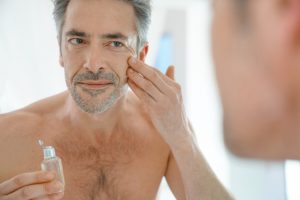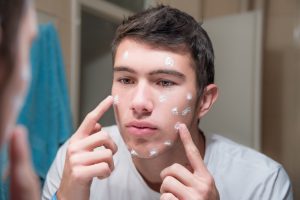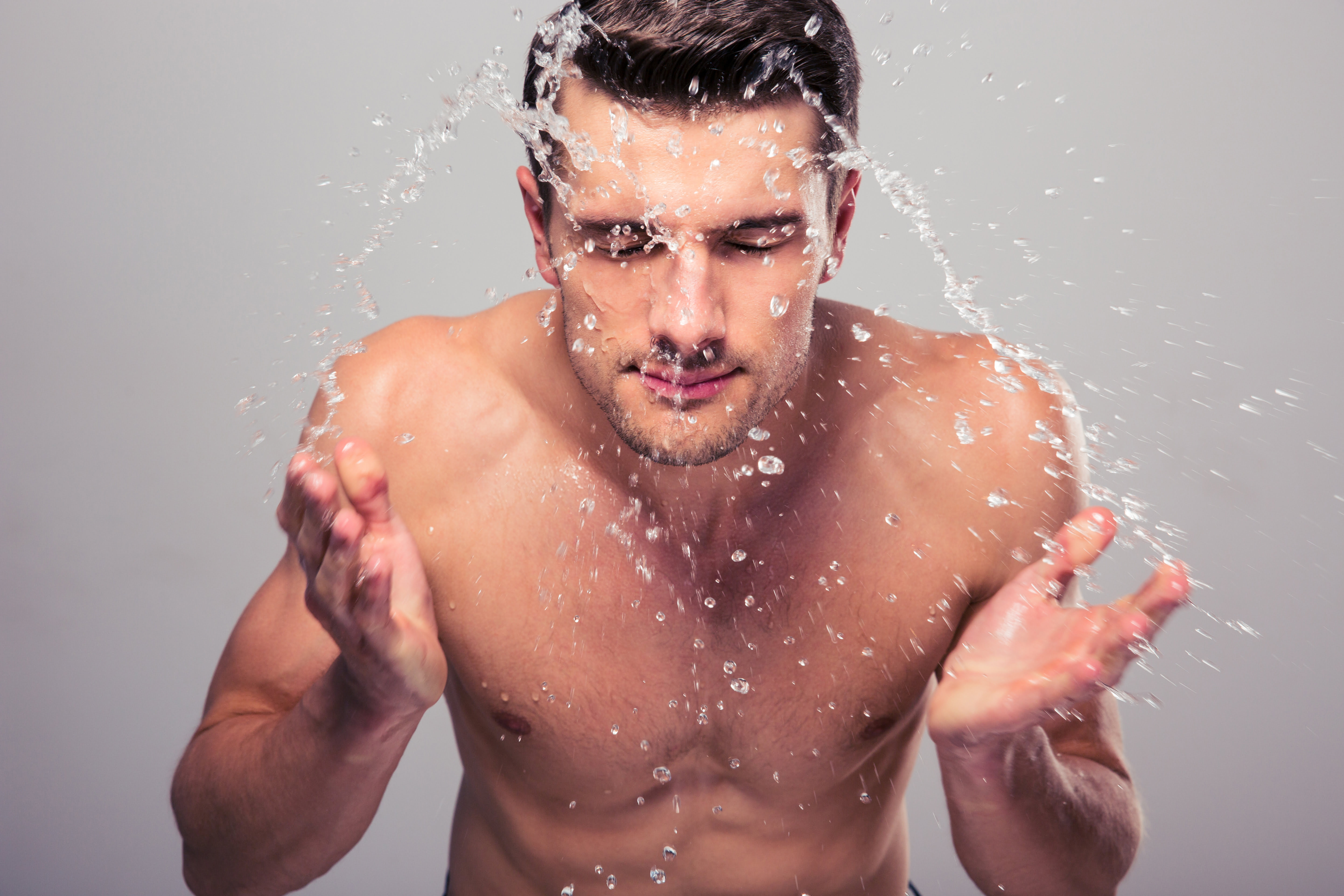In the November/December issue of Retail Pharmacy Assistants e-magazine, we spoke with two health professionals from the Skin Health Institute in Melbourne about skincare routines and what pharmacy assistants need to be mindful of when making recommendations to their male customers.
Skincare differences between men and women
According to Dr Kajal Patel and Associate Professor Rosemary Nixon from the Skin Health Institute in Melbourne, “there are a few skin measurements that can be used to compare males and females, but practically, the main difference is that men have greasier skin from increased sebum production [while] sebum content is decreased in women over their lifetime”.1
They explain that this increased sebum production in men generally means that “men don’t have to worry about moisturising their skin” to the degree that women might.
“We commonly say to all people, your sunscreen should be your moisturiser,” the pair said. “However, men may need a lighter product than women, because of their underlying greasier skin. This can be applied after shaving.”
According to Dr Patel and Associate Professor Nixon, the parameters typically used when comparing the skin of men with that of women include:
- “Young men have higher levels of stratum corneum hydration than women. However, this declines after the age of 40 years in men, whereas in women the levels remain stable or increase with age.”1
- “Males have greater skin collagen. Skin thickness in men decreases constantly from the age of 20 but remains constant in women until approximately the age of 50.4 Decrease in skin thickness is a result of hormonal imbalances from menopause.5
- “Skin pH is lower (i.e., more acidic) in males and increases with age.2 Lower pH may mean more resistance to infection. There are some skin conditions that are more common in women, e.g., rosacea.
- “Skin elasticity is reported to be higher in females than males6. Men showed increased forehead wrinkles compared with women in a Japanese study, in people aged under 60 years.”7
Common skin issues facing men
“The most obvious skin issue that varies between the sexes relates to beard hair and shaving,” Dr Patel and Associate Professor Nixon said.
“Facial pseudofolliculitis barbae (also known as shaving bumps or shaving rash) is more common in men.”
Another issue is acne.
However, interestingly, the pair say that in adolescence (and in adulthood) females are more prone to acne than males. The key difference is that when males get acne, they’re more likely to experience it more severely,8 they add.
“Men are more prone to develop seborrheic dermatitis (dandruff),” they said. “As well as presenting with scalp scaling, there may be scaling on the glabella area (at the top of the nose), on the sides of the nose and involving the eyebrows.
“First-line treatment comprises an antifungal shampoo used twice weekly, containing ketoconazole. An over-the-counter hydrocortisone-clotrimazole cream may be useful for scaly skin on the face.
“Finally, men may be more prone to tinea of the groin and/or the feet. Topical antifungal creams are appropriate first-line treatments.”
Managing common skin issues
One of the most common skin issues facing men is shaving rash. To help manage this, Dr Patel and Associate Professor Nixon suggest shaving after taking a shower, “so that the skin is appropriately hydrated”.
“Less hydrated skin is more easily irritated,” they said. “[Men] should always shave in the direction of skin growth – and old-fashioned barbers can advise about this.
“Use of topical antibacterial products as used in acne, such as benzoyl peroxide-containing products, may be helpful. There are benzoyl peroxide gels or washes available over the counter from the chemist.”
In acute situations, the pair say, shaving rash can be managed by halting shaving for a few days. In more severe cases, a prescription antibiotic lotion may be required. As such, it’s important for pharmacy assistants to dig a little deeper and determine the extent of the issue if customers are coming into the pharmacy complaining of shaving rash.
“Maintaining good hygiene when shaving is also important: ensuring changing blades regularly,” the pair added. “Male teenagers may appreciate advice on over-the-counter acne preparations.”
Additionally, when it comes to cleansing, while most men may be able to tolerate soap in the shower, for those with sensitive skin, Dr Patel and Associate Professor Nixon recommend the use of soap substitutes – and following cleansing, even though “night-time moisturisers are rarely necessary”.
“There are a variety of skincare ingredients [in these products] that are considered to have modest benefits,” they said. “These include topical retinoids, antioxidants, vitamins and nicotinamide.
Underscoring the importance of sunscreen, “the most important way that men can look after their skin and prevent the skins of skin ageing is the appropriate use of sunscreen,” they add.
“The SunSmart smartphone app from the Cancer Council in Victoria provides guidance on the times of the year and the times of day when sunscreen is required for sun protection,” the pair said.
The role of lifestyle
Dr Patel and Associate Professor Nixon say lifestyle factors, especially smoking, excessive sun exposure, diet and sleep, impact skin health in both men and women.
“In addition to increasing the risk of other medical conditions, smoking contributes to premature skin ageing and reduces skin elasticity,” they said.
“Excessive sun exposure contributes to skin damage. Foods high in sugar and dairy have been linked to increased skin inflammation, [and] wholefood, plant-based diets have been linked to younger-looking skin.”9
They continued: “Polyunsaturated and monounsaturated fats have been shown to reduce and modulate skin inflammation.10 Latreille et al11 observed a significant association between monounsaturated fat intake and skin ageing in men.
“Getting the recommended eight hours of sleep a night is important, as poor sleep is related to skin itch and dry skin.”12
The pharmacy assistant’s role
“Pharmacy assistants can particularly advise on the use of sun protection and point to the different preparations of sunscreens available (creams, lotions, gels, sprays, roll-ons) and also advise on the preferred use of broad-brimmed hats, not caps,” Dr Patel and Associate Professor Nixon said.
“They can advise on the basics of shaving rashes.
“Other areas where over-the-counter treatments are appropriate, include dandruff, acne and tinea.
“Medical advice should be sought if skin conditions persist, and especially if they’re causing embarrassment and impacting on the quality of life.”
References:
- Luebberding S, Krueger N, Kerscher M. ‘Mechanical properties of human skin in vivo: A comparative evaluation in 300 men and women’. Skin Res Technol, 2014; 20 (2): 127-135.
- Bailey SH, Oni G, Brown SA, Kashefi N, Cheriyan S, Maxted M. ‘The use of non-invasive instruments in characterising human facial and abdominal skin’. Lasers Surg Med, 2012; 44: 131-142.
- Li X, Galzote C, Yan X, Li L, Wang X. ‘Characterisation of Chinese body skin through in vivo instrument assessments, visual evaluations, and questionnaire: Influences of body area, inter-generation, season, sex, and skincare habits’. Skin Res Technol, 2014; 20 (1): 14-22.
- Shuster S, Black MM, McVitie E. ‘The influence of age and sex on skin thickness, skin collagen and density’. Br J Dermatol, 1975; 93 (6): 639-643.
- Leveque JL, Corcuff P, de Rigal J, Agache P. ‘In vivo studies of the evolution of physical properties of the human skin with age’. Int J Dermatol, 1984; 23 (5): 322-329.
- Firooz A, Sadr B, Babakoohi S, et al.’ Variation of biophysical parameters of the skin with age, gender, and body region’. Scientific World Journal. 2012; 2012:386936.
- Tsukahara K, Hotta M, Osanai O, Kawada H, Kitahara T, Takema Y. ‘Gender-dependent differences in degree of facial wrinkles’. Skin Res Technol, 2013; 19 (1): e65-71.
- Skroza N, Tolino E, Mambrin A, et al. ‘Adult acne versus adolescent acne: A retrospective study of 1167 patients’. J Clin Aesthet Dermatol, 2018; 11 (1): 21-25.
- Solway J, McBride M, Haq F, Abdul W, Miller R. Diet and dermatology. ‘The role of a whole-food, plant-based diet in preventing and reversing skin ageing: A review’. J Clin Aesthet Dermatol, 2020; 13 (5): 38-43.
- Galland L. ‘Diet and inflammation’ <itals>Nutr Clin Pract<itals>, 2010; 25 (6): 634-640.
- Latreille J, Kesse-Guyot E, Malvy D, et al. ‘Dietary monounsaturated fatty acids intake and risk of skin photoageing’. PLoS One, 2012; 7 (9): e44490.
- Sawada Y, Saito-Sasaki N, Mashima E, Nakamura M. ‘Daily lifestyle and inflammatory skin diseases’. Int J Mol Sci, 2021; 22 (10).







